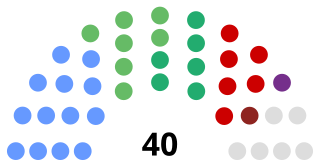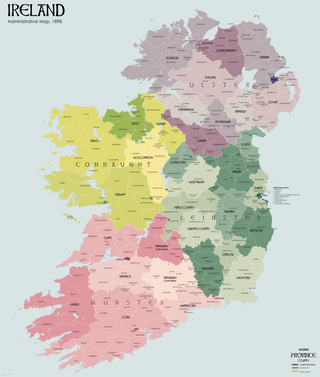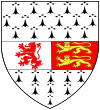
North Tipperary was a county in Ireland in the province of Munster. It was named after the town of Tipperary and consisted of 48% of the land area of the traditional county of Tipperary. North Tipperary County Council was the local authority for the county. In 2011, the population of the county was 70,322.

South Tipperary was a county in Ireland in the province of Munster. It was named after the town of Tipperary and consisted of 52% of the land area of the traditional county of Tipperary. South Tipperary County Council was the local authority for the county. The population of the county was 88,433 according to the 2011 census. It was abolished on 1 June 2014, and amalgamated with North Tipperary to form County Tipperary under a new Tipperary County Council.
Dublin County Council was a local authority for the administrative county of County Dublin in Ireland.

Dún Laoghaire–Rathdown is a county in Ireland. It is in the province of Leinster and the Eastern and Midland Region. It is one of three successor counties to County Dublin, which was disestablished in 1994. It is named after the former borough of Dún Laoghaire and the barony of Rathdown. Dún Laoghaire–Rathdown County Council is the local authority for the county. The population of the county was 233,860 at the time of the 2022 census.

Galway City Council is the local authority of the city of Galway, Ireland. As a city council, it is governed by the Local Government Act 2001. The council is responsible for housing and community, roads and transportation, urban planning and development, amenity and culture, and environment. The council has 18 elected members. Elections are held every five years and are by single transferable vote. The head of the council has the title of mayor. The city administration is headed by a chief executive, Patricia Philbin. The council meets at City Hall, College Road, Galway.

A local electoral area is an electoral area for elections to local authorities in Ireland. All elections use the single transferable vote. The Republic of Ireland is divided into 166 LEAs, with an average population of 28,700 and average area of 423.3 square kilometres (163.4 sq mi). The boundaries of LEAs are determined by order of the Minister for Housing, Local Government and Heritage, usually based on lower-level units called electoral divisions (EDs), with a total of 3,440 EDs in the state.

Galway County Council is the local authority of County Galway, Ireland. As a county council, it is governed by the Local Government Act 2001. The council is responsible for housing and community, roads and transportation, urban planning and development, amenity and culture, environment, and local fire services. The council has 39 elected members. Elections are held every five years and are by single transferable vote. The head of the council has the title of Cathaoirleach (chairperson). The county administration is headed by a chief executive, Liam Conneally. The county seat is at Áras an Chontae in Galway city.

Clare County Council is the local authority of County Clare, Ireland. As a county council, it is governed by the Local Government Act 2001. The council is responsible for housing and community, roads and transportation, urban planning and development, amenity and culture, and environment. The council has 28 elected members who are elected for a five-year term. The head of the council has the title of Cathaoirleach (chairperson). The county administration is headed by a chief executive, Pat Dowling. The county town is Ennis.

Cavan County Council is the authority responsible for local government in County Cavan, Ireland. As a county council, it is governed by the Local Government Act 2001. The council is responsible for housing and community, roads and transportation, urban planning and development, amenity and culture, and environment. The council has 18 elected members. Elections are held every five years and are by single transferable vote. The head of the council has the title of Cathaoirleach (chairperson). The county administration is headed by a chief executive, Tommy Ryan. The county town is Cavan.

Laois County Council is the local authority of County Laois, Ireland. As a county council, it is governed by the Local Government Act 2001. The council is responsible for housing and community, roads and transportation, urban planning and development, amenity and culture, and environment. The council has 19 elected members. Elections are held every five years and are by single transferable vote. The head of the council has the title of Cathaoirleach (chairperson). The county administration is headed by a chief executive, John Mulholland. The county town is Portlaoise.

Offaly County Council is the local authority of County Offaly, Ireland. As a county council, it is governed by the Local Government Act 2001. The council is responsible for housing and community, roads and transportation, urban planning and development, amenity and culture, and environment. The council has 19 elected members. Elections are held every five years and are by single transferable vote. The head of the council has the title of Cathaoirleach (chairperson). The county administration is headed by a chief executive, Anna Marie Delaney. The county town is Tullamore.

Cork County Council is the local authority of County Cork, Ireland. As a county council, it is governed by the Local Government Act 2001, as amended. The council is responsible for housing and community, roads and transportation, urban planning and development, amenity and culture, and environment. The council has 55 elected members. Elections are held every five years and are by single transferable vote. The head of the council has the title of Mayor. The county administration is headed by a chief executive, Valerie O'Sullivan. The county seat is Cork.

North Tipperary County Council was the local authority of the county of North Tipperary, Ireland, from 1899 to 2014. The head of the council had the title of Mayor. The county town was Nenagh.

Dún Laoghaire–Rathdown County Council is the local authority of the county of Dún Laoghaire–Rathdown, Ireland. It is one of three local authorities that succeeded the former Dublin County Council on its abolition on 1 January 1994 and one of four councils in the old County Dublin. As a county council, it is governed by the Local Government Act 2001. The council is responsible for housing and community, roads and transportation, urban planning and development, amenity and culture, and environment. The council has 40 elected members. Elections are held every five years and are by single transferable vote. The head of the council has the title of Cathaoirleach (chairperson). The county administration is headed by a chief executive, Frank Curran. The county town is Dún Laoghaire. It serves a population of approximately 206,260.

Fingal County Council is the local authority of the county of Fingal, Ireland. It is one of three local authorities that succeeded the former Dublin County Council on abolition on 1 January 1994 and is one of four local authorities in County Dublin. As a county council, it is governed by the Local Government Act 2001. The council is responsible for housing and community, roads and transport, urban planning and development, amenity and culture, and environment. The council has 40 elected members. Elections are held every five years on the electoral system of proportional representation by means of the single transferable vote (PR-STV). The head of the council has the title of Mayor. The county administration is headed by a chief executive, AnnMarie Farrelly. The county town is Swords.

Tipperary County Council is the local authority of County Tipperary, Ireland. As a county council, it is governed by the Local Government Act 2001. The council is responsible for housing and community, roads and transportation, urban planning and development, amenity and culture, and environment. The council has 40 elected members. Elections are held every five years and are by single transferable vote. The head of the council has the title of Cathaoirleach (chairperson). The county administration is headed by a chief executive, Joe MacGrath. The administrative centres are Nenagh and Clonmel.

An election to all 18 seats on Carlow County Council was held on 23 May 2014 as part of the 2014 Irish local elections. County Carlow was divided into two local electoral areas (LEAs) to elect councillors for a five-year term of office on the electoral system of proportional representation by means of the single transferable vote (PR-STV).
Local government in Dublin, the capital city of Ireland, is currently administered through the local authorities of four local government areas. The historical development of these councils dates back to medieval times.

Urban and rural districts were divisions of administrative counties in Ireland created in 1899. These local government areas elected urban district councils (UDCs) and rural district councils (RDCs) respectively which shared responsibilities with a county council. They were established when all of Ireland was part of the United Kingdom.




















